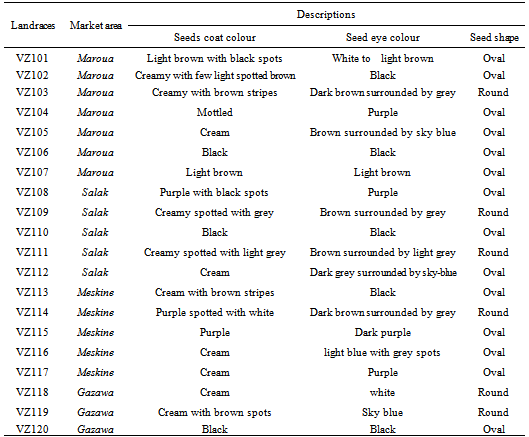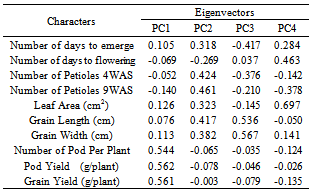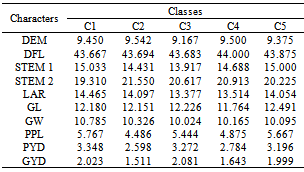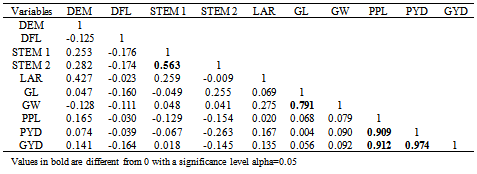| [1] | L. S. T. Ngamo & T. H. Hance, Diversité de ravageurs et denrées ; méthodes alternatives de lutte en milieu tropical. In TROPICULTURA, 25(4) : 215-220, 2007 |
| [2] | A.M. Oparaeke and J.O. Bunmi, Bioactivity of two podered spices (piper guineense) (Dunal) A. Richard) as home masses insecticides against Callosobruchus subinnotatus (pic) on stored Bambarra groundnut. In: Agricultura tropical et subtropical, 39(2) pp 132-133, 2006 |
| [3] | FAO Stat Database. http//www.fao.org/statistic, 2013 |
| [4] | Yao Djè., S. Beket, Bonny, A. Irié and Zoro Bi, «Observation préliminaire de la variabilité entre quelques morphotypes de voandzou (Vigna subterranea L. Verde ; Fabaceae) de Cote d’Ivoire», Biotechn, Agron. Soc. Environ ; 9 (4) pp 249-258, 2005 |
| [5] | J. Heller, F. Begemann, et J. Mushonga, Bambara groundnut Vigna subterranean (L.) Verdc. Conservation and improvement of Bambara groudnut (Vigna subterranea (L.) Verdc.). Harare, Zimbabwe: International Plant Genetic Resources Institute. pp 166, 1997 |
| [6] | M. Brink, G.M. Ramolemana, et K.P. Sibuga. Vigna subterranean (L.) Verde in Brink. M. & Belay. G. (éditeurs) PROTAI cereals and pulses/cereals et legumes secs. (CD-Room). PROTA, Wageningen, Pays Bas, 2006 |
| [7] | I. A. Onimawo, A. H. Momoh, A. Usman. Proximate composition and functional properties of four cultivars of bambara groundnut (Voandzea subterranea). Plant Foods Hum. Nutr. 53, pp. 153-158, 1998 |
| [8] | D. R. Minka and M. Brunetau, Partial chemical composition of Bambarra pea (Vigna subterranea L. Verdc.). Food Chem., 68: pp 273-276, 2000 |
| [9] | J.O. Amarteifio, O. Tibe et R. M. Njogu, The mineral composition of Bambara groundnut (Vigna subterranea (L) Verdc) grown in Southern Africa. African Journal of Biotechnology 5: 2408-2411, 2006 |
| [10] | B. B. Singh, O. L. Chambliss, and B. Sharma, Recent advances in cowpea breeding. In: Singh B., B., Mohan Raj D., R., Dashiell, K., E., Jackai LEN (eds) Advances in cowpea research, Co publication of International Institute of Tropical Agriculture (IITA), Ibadan, Nigeria and Japan International Research Centre for Agricultural Sciences (JIRCAS), Sayce Publishing, Devon : 114–128, 1997 |
| [11] | W. H. Ntund., I. C. Bach, J. L. Christiansen Et S. B. Andersen, Analysis of genetic diversity in Bambara groundnut (Vigna subterranea (L.) Verdc) landraces using amplified fragment length polymorphism (AFLP) markers. African Journal of Biotechnology 3: 220-225, 2004 |
| [12] | M. Ouedrago, J. T. Ouedrago, J. B. Tignere, D. Balma, C. B. Dabire & G. Konate, Characterization and evaluation of accessions of Bambara groundnut (Vigna subterranea (L.) Verdcourt) from Burkina Faso. Sciences & Nature Vol. 5 N°2 : 191 – 197, 2008 |
| [13] | P. Eyzaguirre , I. Thormann, A. E. Goli et A. F. Attere, Strategies for the conservation and use of neglected and under-utilized crops in the African savannah: fonio and bambara groundnut. In A. Begic (Ed). Actes du colloque “Gestion des ressources génétiques des plantes en Afrique des savanes”, 24–28 février, 1997, IER-BRG-Solagral, Bamako, Mali, p. 315–322, 1997 |
| [14] | S. N. Azam-Ali , A. Sesay, K. S. Karikari, F. J. Massawe, J. Aguilar-Manjarrez., M. Bannayan and K. J. Hampson, Assessing the potential of an underutilized crop - a case study using bambara groundnut. Exp. Agric.,37: p. 433–472, 2001 |
| [15] | M. Diouf, C. Lo, M. Gueye, N. B. Mbengue, Sélection participative de nouveaux cultivars de quatre (4) espèces de légumes-feuilles (Hibiscus sabdariffa L., Amaranthus L. spp, Vigna unguiculata (L.) WALP et Moringa oleifera L. am) au Sénégal. Afri. J. Food Agric. Nutr. Dev., 7(3): 17, 2007 |
| [16] | P. Donfack, B. Seiny et M. M’biandoum, Les grandes caractéristiques du milieu physique. In “Colloques-CIRAD” Montpellier : CIRAD-CA, pp. 29-42, 1997 |
| [17] | P. H. A. Sneath and R. O Sokal, Numerical taxonomy, Freeman, San Francisco, 1973. |
| [18] | D. L. Swofford, G. J. Olsen, Phylogeny reconstruction .In Hillis D.M., Moritz C., (eds.) Molecular systematic Sinauer Associates, Sunderland, pp. 411-501, 1990 |
| [19] | IPGRI, IITA., et BAMNET, Descriptors for bambara groundnut (Vigna subterranea). International Plant Genetic Resources Institute, Rome Italy; International Institute of Tropical Agriculture, Ibadan, Nigeria; The International Bambara Groundnut Network, Germany. 57 pp, 2000 |
| [20] | Y. Touré1, M. Koné1, H. Kouakou Tanoh & D. Koné, Agromorphological and Phenological Variability of 10 Bambara Groundnut[Vigna subterranea (L.) Verdc. (Fabaceae)] landraces cultivated in the Ivory Coast, TROPICULTURA, 30(4) : 216-221, 2012 |
| [21] | S. K. Karikari, Variability between local and exotic Bambara groundnut landraces in Botswana. Afr. Crop Sci. 8, 153-157.Noorzaei, J., Viladkar, M. N., Godbole, P. N., 1995, Influence of strain hardening on soil-structure interaction of framed structures, Computers & Structures, 55(5), 789-795, 2000 |
| [22] | K. Adéoti, A. Dansi , L. Ahoton, R. Vodouhè, B. C. Ahohuendo, A. Rival A and A. Sanni, Agromorphological characterization of Sesamum radiatum (Schum. and Thonn.), a neglected and underutilized species of traditional leafy vegetable of great importance in Benin. African Journal of Agricultural Research Vol. 7(24), pp. 3569-3578, 2012 |
| [23] | T. Stoilova and G. Pereira, Assessment of the genetic diversity in a germplasm collection of cowpea (Vigna unguiculata (L.) Walp.) using morphological traits, African Journal of Agricultural Research Vol. 8(2), pp. 208-215, 2013 |
| [24] | A. M. Mih, K. R. Tonjock and L. M. Ndam, Morphological characterization of four selections of Vernonia hynenolepis A. Rich. (Asteraceae). World Journal of Agricultural Sciences, 4(2): 220-223, 2008. |
| [25] | H. B. Abu and S. S. J. Buah, Characterization of Bambara Groundnut Landraces and Their Evaluation by Farmers in the Upper West Region of Ghana. Journal of Developments in Sustainable Agriculture 6:64-74, 2011 |
| [26] | M. Brink, S. T. Collinson and D. J. Wigglesworth, Characteristics of Bambara groundnut cultivation in Botswana. In: Azam-Ali, S., N., Sesay, A., Collinson, S.T. (Eds), Proceedings of the International Bambara Groundnut Symposium held at University of Nottingham, U.K., 23-25 july 1996, 133-142, 1996. |
| [27] | F. K. Kumaga, S. G. K. Adiku and K. Ofori, Effect of post-flowering water stress on dry matter and yield of three tropical grain legumes. Int. J. Agric. Biol., 5: 405-407, 2003. |
| [28] | N. I. C. Onwubiko, O. B. Odum, C. O. Utazi and P. C. Poly-Mbah, Studies on the Adaptation of Bambara Groundnut (Vigna subterranea(L. Verdc) in Owerri Southeastern Nigeria. Agricultural Journal 6 (2): 60-65, 2011 |
| [29] | M. A. Adebesi, O. J. Ariyo and O. B. Kehinde, Variation and correlation studies in quantitative characters in soybean. The Ogun J. Agri. Sci., 3(1): 134-142, 2004 |
| [30] | P. M. Jonah, Phenotypic and Genotypic Correlation in Bambara groundnut (Vigna subterranean (L.) verdc in Mubi, Adamawa State, Nigeria. World Journal of Agricultural Sciences 7(30): 298-303, 2011 |
| [31] | B. C. Oyiga and M. I. Uguru, Interrelationships among Pod and Seed Yield Traits in Bambara Groundnut (Vigna subterranea L. Verdc) in the Derived Savanna Agro-Ecology of South-Eastern Nigeria under Two Planting Dates. International Journal of Plant Breeding 5(2): 106-111, 2011. |

 Y= Pod or Grain yield (g/plant)W = Total Pod or Grain weight (g)NP = Total Number of plant harvested
Y= Pod or Grain yield (g/plant)W = Total Pod or Grain weight (g)NP = Total Number of plant harvested 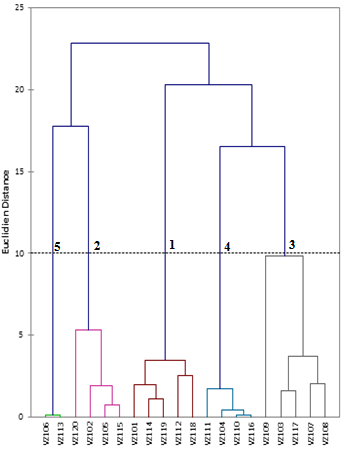
 Abstract
Abstract Reference
Reference Full-Text PDF
Full-Text PDF Full-text HTML
Full-text HTML